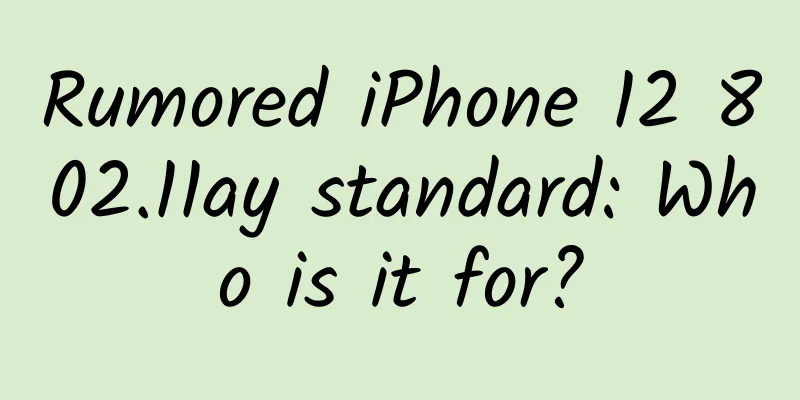Rumored iPhone 12 802.11ay standard: Who is it for?

|
Recently, there have been rumors that the iPhone 12 will introduce IEEE 802.11ay wireless technology, which has triggered a series of discussions. 802.11ay is the IEEE 802.11 series wireless local area network (WLAN) communication protocol, which operates in the ultra-high-speed, low-interference 60GHz frequency band and is a subsequent upgraded version of 802.11ad (similar to 802.11ax to 802.11ac). What we are concerned about is what new changes 802.11ay can bring to the iPhone and what functions this improvement is intended for. First of all, we need to understand what the 802.11ay standard is. The 802.11ac currently in mainstream use is a 2.4GHz and 5GHz frequency band standard. After the 802.11ac standard, there is also the 802.11ad standard that was created specifically to increase transmission speeds. This standard is based on a wireless network in the 60GHz frequency band. The familiar Wi-Fi IEEE 802.11ac / IEEE 802.11ax are 2.4GHz and 5GHz frequency band standards. After the 802.11ac standard, there is also the 802.11ad standard, which is specially designed to increase the transmission speed. This standard is based on the 60GHz frequency band wireless network. 802.11ay is an evolution of 802.11ad, supporting a higher-order modulation mechanism of 256QAM. It can bind up to 2~4 channels at a time, with a theoretical bandwidth of 176Gbps. In theory, a Blu-ray movie can be downloaded in 1 second. Both 802.11ad and 802.11ay standards run on high frequency bands to increase transmission speeds, but the disadvantage is that they are almost impossible to penetrate walls and are not suitable for home use. Therefore, the iPhone 12 cannot only support 802.11ay, but must also support the existing 802.11ax standard. The 802.11ax standard is the currently designated WiFi 6, which runs on the 2.4GHz and 5GHz frequency bands and is also suitable for daily home use. Apple's iPhone 11/11 Pro series already supports this technology. In 2018, Qualcomm announced the launch of the first two 60GHz Wi-Fi chipsets, QCA64x8 and QCA64x1, which can provide up to 10+Gbps network speed and low latency for mobile phones, laptops, routers, etc., while also consuming less power. This is the industry's first 60GHz Wi-Fi solution based on the new WiGig standard 802.11ay, and it also lays the foundation for Apple to use 802.11ay technology faster after rejoining hands with Qualcomm. It should be noted that if the iPhone 12 really supports the 802.11ay standard as rumored, this would be an advanced move, because the 802.11ay standard may not release a final specification until the end of 2020. Now everyone should understand that the iPhone 12 will undoubtedly continue to support WiFi 6, which is the mainstream 802.11ax, and will also support the ultra-short-range and ultra-high-speed 802.11ay. What 802.11ay does: For Apple, 802.11ay will be the perfect technology to increase AirDrop transmission speed, providing the best conditions for seamless file sharing between Mac/iPhone/iPad in the future. More importantly, the 802.11ay standard will be key to connecting iPhones with future Apple accessories. Since 802.11ay can provide reasonably high bandwidth and low latency, it can be used to send data to high-resolution, high-refresh-rate displays, and is expected to be used in scenarios such as high-quality image transmission and wireless projection of other screens: such as virtual reality (VR) or augmented reality (AR) glasses. This is the goal of the standard since its birth, and Qualcomm QCA64x8 and QCA64x1 chipsets are also prepared for AR and VR. According to a report by The Information, at an internal meeting last October, Mike Rockwell, head of Apple's AR/VR department, announced the AR roadmap to a team of up to 1,000 people. The company plans to release a headset with AR and VR functions in 2022, which is similar to the all-in-one VR machine Oculus Quest, but thinner and lighter; and will launch lighter AR glasses in 2023. Media reports say that if all processing of the AR/VR product experience is done on the device itself, making it a completely independent product, it will be larger, heavier, more expensive, and battery life will become a bottleneck. However, there is another option, that is, the headset is just a display, and all processing is done on the iPhone 12. Considering that the 802.11ay standard is essential for transmitting data between Apple glasses and iPhones, this speculation makes sense.
Considering that Apple Glasses may have to wait until 2022 or 2023, the improvement in AirDrop transmission speed may be the most realistic reason for the new generation of iPhones to support 802.11ay. However, we are still looking forward to the breakthrough of the existing AR/VR experience due to the widespread application of 802.11ay, which will be the beginning of the next era of interaction. |
<<: Mobile QQ 8.2.8 update: Image text extraction is easier
>>: As mobile phone screens get bigger and bigger, what challenges do UX designers face?
Recommend
How to implement content operation and common methods!
Just talking about operations, many friends may b...
How to cleverly use celebrities to achieve a cold start for a product?
For those who work in operations , the word they ...
The APPStore hot search list rose by 300 places in the magical hour
If I knew magic, I would make sure that my own pr...
Five reasons why you shouldn't upgrade to iOS 13 or iPadOS right now
Today, Apple released the public beta version of ...
How to use short videos to direct traffic to the live broadcast room!
This is a relatively hardcore article. In additio...
10 common problems in Kuaishou short video operation, must-read for beginners
The rapid development of the Internet has also le...
A review of marketing cases in 2021
The meaning of advertising is publicity, but it i...
Douyin's anti-addiction measures upgraded! All real-name users under 14 years old enter youth mode
[[424652]] On September 17th, today, Douyin offic...
Five major changes have taken place in the Silicon Valley technology circle in the past year
[[161334]] The year 2015 that just passed was bot...
APP promotion: What is it like to operate a bad product?
Someone invited me to answer a question on Zhihu....
How many nucleic acid tests will be conducted during the lockdown in Puxi, Shanghai in 2022? When will the blockade be lifted? Attached the latest news
In order to cope with the severe local epidemic, t...
Tik Tok’s 3 loops to retain users and its commercialization trends!
This article is mostly the author's own thoug...
How are the App Store rankings determined? How to get on the top of the rankings
In the past two years, Xu Huaizhe and Liu Xiong h...
Six steps for Xiaohongshu UP masters to make money. Even novices can earn more than 5,000 yuan a month by mastering the methods
The core significance of the Xiaohongshu APP: Xia...
WeChat Index is here, how to use it well is limited only by your imagination
Recently, WeChat launched the " WeChat Index...









